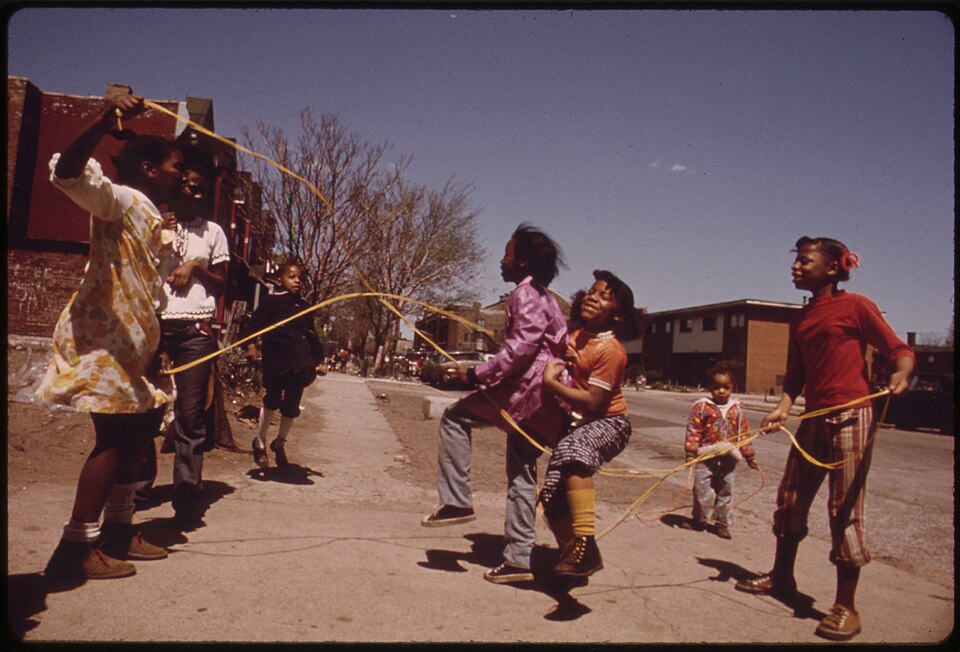
I was pleasantly surprised by an email from one of my closest friends who shared the announcement of Mary "Dancin' Mary," a Double Dutch enthusiast from Castle-Enyard and LA Hollywood, doing what they love and making people smile while strengthening community bonds.
The Logan Center Courtyard at University of Chicago hosted an energetic session of jump rope, movement, and music led by Bernadette Rapier. She commented that it was her favorite sport. I quickly chimed in that it was a close second to roller skating for me. Then I began to reminisce about the childhood games/sports of my Baby Boomer youth and really winced a little when I think of the absence of those wonderful ways we played as children back then.
I haven't even mentioned Tetherball, which was very popular. We'll get to that later.
Double Dutch: More Than Just a Game
It is somehow rumored that Double Dutch was born on the streets of New York City and is steeped in rich cultural history. Double Dutch is a dynamic game that has evolved into a competitive sport with a global following. It's a game of rhythm, skill, and creative expression, all centered around two ropes and the people who turn and jump them.
A Brief History: From Street Corners to Competition
The truth is that while the exact origins of Double Dutch are debatable—it is presumed that the original form of Double Dutch arrived with the Dutch settlers to America, while others claim it emerged independently in the United States in the early 1900s. What we know to be true is that its modern form emerged in the 1950s in predominantly Black urban areas of New York City, particularly Harlem. On street corners, young Black girls would gather to jump Double Dutch, and as is traditional amongst African descendant peoples, the appreciation for self-expression within a construct allows one to showcase new moves that they developed. The sport or art form was one that was inexpensive, demanding only one's time, commitment, and ability. Often using clotheslines as ropes made it an affordable sport to participate in and master.
The way the African American girls turned the ropes in a rhythm natural to that of their inner spirits complemented the jumping of those inside between two ropes as the turners grooved with the jumper. It was embraced and became a beloved and popular urban outdoor street activity performed on the sidewalks and later in driveways and on school property playgrounds. During its growth and development period, I indulged in Double Dutch in Cincinnati, like so many little girls across the country from Philly to Baltimore, to Chicago, to Detroit, to St. Louis, to Los Angeles. It was very much a part of our African American culture.
I remember looking forward to jumping Double Dutch, especially when we jumped as teams for placement earned by scores. It was all about how long you could keep that rhythm flowing inside the two ropes that you jumped as they turned around you. It was always competitive, but it wasn't until the 1970s that it began its transformation into a formal sport.
Transitioning into a legitimate sport owes much to NYPD officers Ulysses Williams and David Walker, who were instrumental in this change. They formalized the rules for competition, and the first official Double Dutch contest was held in 1974. From there, it grew from local block parties to a worldwide phenomenon. In a significant step for the sport, Double Dutch became a varsity sport in New York City public high schools in 2009.
The Art of the Jump
Imagine that... the "art of jump." Double Dutch involves at least three people: two turn the long ropes in opposite directions, and one or more jumpers perform inside. So, a team would include the turners and the jumper. The jumpers are the performers, showcasing an impressive array of rhythmic moves which include turns, double steps, splits, and half or full turns, and more recently the incorporation of gymnastics, breakdancing, and intricate footwork—all done inside the two ropes that continue to turn until the jumper loses their rhythm and missteps, causing them to collide with the ropes. In competitive play, judges evaluate key elements like footwork, power, and gymnastics, as well as the synchronicity between the jumpers and turners. Be clear that jumping Double Dutch is an art, and if studied and practiced, it is a category of its own, utilizing the agility and strength of a dancer and the control and organized synchronicity of a gymnast.
A Global Community
Today, Double Dutch is played and celebrated around the world, from local events to international championships. Organizations like the National Double Dutch League (NDDL), founded by David A. Walker, hold yearly competitions like the Holiday Classic, drawing teams from all over the globe.
The sport is also a key component of major jump rope tournaments and is featured in the AAU Junior Olympic Games and the World Jump Rope Federation's annual competitions. These events categorize the sport into different types of play, including compulsory routines, freestyle, and speed rope.
Beyond the competitive scene, Double Dutch, as we know it, emerged from the creativity of young American Black girls and has left its mark on popular culture. It's been featured in music videos, films, and television shows, and was an integral part of the early French hip-hop scene. Its rhythmic energy and cultural significance have made it a recognizable and celebrated activity far beyond its New York City roots.

Visionary Kai EL´ Zabar has worked as CEO of arts organizations and as editor, writer and multimedia consultant accumulating a significant number of years in experience as an executive, journalist,publisher, public relations, media training, marketing, internal and external communications. Kai currently continues her life’s work as Editor-in-Chief Of Chicago News Weekly where she has resumed her column, “E NOTES.” She is ecstatic to be in the position to grace Chicago and the world with a publication that articulates the Black voice.